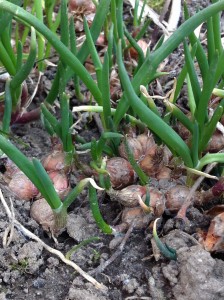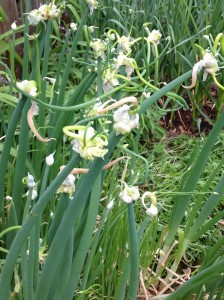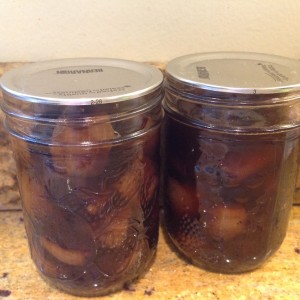If you can get your hands on walking onions, you may wind up with a lifetime supply of green onions. A tough, perennial plant, walking onion bulbs are not usually sold in stores – you need to get them from another gardener. Luckily, gardeners are usually willing to part with them, because they multiply quickly.
 Assuming you have a source, you will likely start with a small cluster of fairly dry looking bulblets. To plant them, break them up into smaller clumps, and throw them on the ground. There, planting done! Just make sure to choose a space where they can live for years, since they will survive most winters, even Canadian winters. You should plant them in the fall, although the spring will be okay too – they will just be a little slower to get going.
Assuming you have a source, you will likely start with a small cluster of fairly dry looking bulblets. To plant them, break them up into smaller clumps, and throw them on the ground. There, planting done! Just make sure to choose a space where they can live for years, since they will survive most winters, even Canadian winters. You should plant them in the fall, although the spring will be okay too – they will just be a little slower to get going.
Early the following spring, your bulblets will start to sprout little green onions. Feel free to use them for cooking as soon as they are large enough. Squirrels and raccoons are not interested in them (whew), so pests are not usually a problem.
 Eventually, a tough stalk will start to grow, and new bulblets will form at the top of the stalk. Sometimes, a second or even a third tier of bulblets will be present. When the stalk dies and collapses, the new bulblets will fall to the ground, effectively planting themselves, and the cycle starts over again. In this way, the onions can “walk” around your garden over time. I usually restrain their wandering by throwing the bulblets back to the proper part of the garden before they have had a chance to establish roots elsewhere. Sort of like herding very slow cats.
Eventually, a tough stalk will start to grow, and new bulblets will form at the top of the stalk. Sometimes, a second or even a third tier of bulblets will be present. When the stalk dies and collapses, the new bulblets will fall to the ground, effectively planting themselves, and the cycle starts over again. In this way, the onions can “walk” around your garden over time. I usually restrain their wandering by throwing the bulblets back to the proper part of the garden before they have had a chance to establish roots elsewhere. Sort of like herding very slow cats.
In the meantime, the original onion will have formed a small white bulb in the ground, similar in size to a cocktail onion. Some people just pull these up and compost them, but we like to pickle them, because pickled balsamic onions are awesome! And why compost food when you can eat it instead?
 Before the onion greens die back in the fall, if you freeze them you can use them for cooking all winter long. Bundle a bunch of greens together tightly to form a large sausage (I’m talking summer sausage, not bratwurst). Wrap with an elastic band or two to keep the bundle tight. Place in a freezer bag and seal, trying to exclude as much air as possible. When you want green onions, simply slice off as much of the sausage as you need (no need to thaw).
Before the onion greens die back in the fall, if you freeze them you can use them for cooking all winter long. Bundle a bunch of greens together tightly to form a large sausage (I’m talking summer sausage, not bratwurst). Wrap with an elastic band or two to keep the bundle tight. Place in a freezer bag and seal, trying to exclude as much air as possible. When you want green onions, simply slice off as much of the sausage as you need (no need to thaw).
Having walking onions in your garden is a great way to get fresh green onions for years to come. It is also a great way to meet other gardeners – you will need to get your original onions from another gardener, and then a few years later you can pass along your wisdom and bulblets to others!

